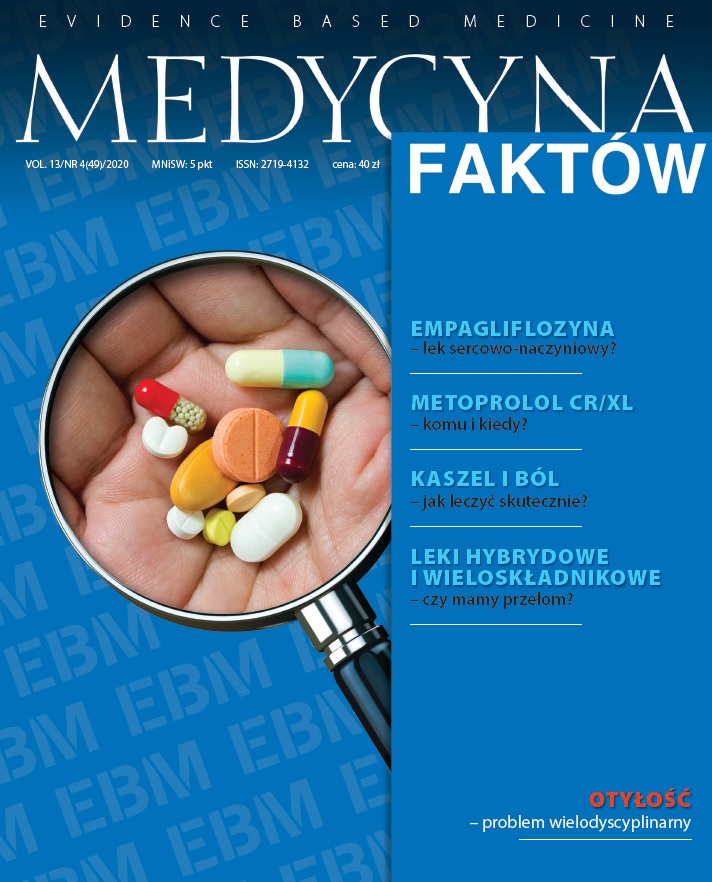7 faktów na temat stosowania metoklopramidu Artykuł przeglądowy
##plugins.themes.bootstrap3.article.main##
Abstrakt
Nudności i wymioty mogą być objawem chorobowym lub stanowić działanie niepożądane stosowanej terapii. Metoklopramid, poprzez działanie polegające na blokowaniu receptora dopaminowego D2 oraz receptora histaminowego 5-HT3, powodując przyspieszone opróżnianie żołądkowe i pobudzenie perystaltyki jelit, ma udowodnioną skuteczność w leczeniu nudności i wymiotów w wielu wskazaniach. Jest skuteczny w ramach terapii objawowej niezależnie od przyczyny. Warto zwrócić uwagę na sytuacje szczególne, takie jak migrena, gastropareza cukrzycowa, u pacjentów po chemio- i radioterapii, po leczeniu operacyjnym, w których metoklopramid ma udowodnioną, najczęściej w badaniach z randomizacją, skuteczność. Pomimo możliwości wystąpienia istotnych powikłań (w tym zespołu pozapiramidowego) metoklopramid można uznać za lek bezpieczny, przy założeniu odpowiedniego doboru pacjentów oraz ostrożności w stosowaniu. Jego użycie jest możliwe również w przypadku kobiet w ciąży oraz dzieci, u których powikłania mają bardzo rzadko długotrwałe następstwa.
##plugins.themes.bootstrap3.article.details##
Copyright © by Medical Education. All rights reserved.
Bibliografia
2. Sanger GJ, Andrews PLR. A History of Drug Discovery for Treatment of Nausea and Vomiting and the Implications for Future Research. Front Pharmacol. 2018; 9: 913.
3. Rosenfeld MR, Dvorkin B, Klein PN et al. Differential affinities of molindone, metoclopramide and domperidone for classes of [3H] spiroperidol binding sites in rat striatum: evidence for pharmacologically distinct classes of receptors. Brain Res. 1982; 235: 205-11.
4. Metoklopramid (access: 25.11.2020).
5. Grover M, Farrugia G, Stanghellini V. Gastroparesis: a turning point in understanding and treatment. Gut. 2019; 68: 2238-50.
6. Camilleri M, Parkman HP, Shafi MA et al. American College of Gastroenterology. Clinical guideline: management of gastroparesis. Am J Gastroenterol. 2013; 108: 18-37.
7. Lee A, Kuo B. Metoclopramide in the treatment of diabetic gastroparesis. Expert Rev Endocrinol Metab. 2010; 5(5): 653-62.
8. Lipton RB, Stewart WF, Diamond S et al. Prevalence and burden of migraine in the United States: Data from the American Migraine Study II. Headache. 2001; 41: 646-57.
9. Colman I, Brown MD, Innes GD et al. Parenteral metoclopramide for acute migraine: meta-analysis of randomised controlled trials. BMJ. 2004; 329: 1369-73.
10. Diener H-C, Holle-Lee D, Nägel S et al. Treatment of migraine attacks and prevention of migraine: Guidelines by the German Migraine and Headache Society and the German Society of Neurology. Clinical and Translational Neuroscience. 2019. http://doi.org/10.1177/2514183X18823377.
11. Derry S, Moore RA. Paracetamol (acetaminophen) with or without an antiemetic for acute migraine headaches in adults. Cochrane Database Syst Rev. 2013; 4: CD008040.
12. Kirthi V, Derry S, Moore RA. Aspirin with or without an antiemetic for acute migraine headaches in adults. Cochrane Database Syst Rev. 2013; 4: CD008041.
13. De Mulder PH, Seynaeve C, Vermorken JB et al. Ondansetron Compared with High-Dose Metoclopramide in Prophylaxis of Acute and Delayed Cisplatin-Induced Nausea and Vomiting: A Multicenter, Randomized, Double-Blind, Crossover Study. Ann Intern Med. 1990; 113(11): 834-40.
14. De Oliveira GS Jr, Castro-Alves LJ, Chang R et al. Systemic metoclopramide to prevent postoperative nausea and vomiting: a meta-analysis without Fujii’s studies. Br J Anaesth. 2012; 109(5): 688-97.
15. Henzi I, Walder B, Tramer MR. Metoclopramide in the prevention of postoperative nausea and vomiting: a quantitative systematic review of randomized, placebo-controlled studies. Br J Anaesth. 1999; 83: 761-71.
16. Bolton CM, Myles PS, Nolan T et al. Prophylaxis of postoperative vomiting in children undergoing tonsillectomy: a systematic review and meta-analysis. Br J Anaesth. 2006; 97(5): 593-604.
17. Lau Moon Lin M, Robinson PD, Flank J et al. The Safety of Metoclopramide in Children: A Systematic Review and Meta-Analysis. Drug Saf. 2016; 39(7): 675-87.
18. Fedorowicz Z, Jagannath VA, Carter B. Antiemetics for reducing vomiting related to acute gastroenteritis in children and adolescents. Cochrane Database Syst Rev. 2011; 9: CD005506.
19. Koren G. Safety considerations surrounding use of treatment options for nausea and vomiting in pregnancy. Expert Opin Drug Saf. 2017; 16(11): 1227-34.
20. Mishriky BM, Habib AS. Metoclopramide for nausea and vomiting prophylaxis during and after Caesarean delivery: a systematic review and meta-analysis. Br J Anaesth. 2012; 108(3): 374-83.
21. Ganzini L, Casey DE, Hoffman WF et al. The prevalence of metoclopramide-induced tardive dyskinesia and acute extrapyramidal movement disorders. Arch Intern Med. 1993; 153(12): 1469-75.
22. Avorn J, Gurwitz JH, Bohn RL et al. Increased incidence of levodopa therapy following metoclopramide use. JAMA. 1995; 274(22): 1780-2.
23. Rao AS, Camilleri M. Review article: metoclopramide and tardive dyskinesia. Aliment Pharmacol Ther. 2010; 31(1): 11-9.
24. Parlak I, Atilla R, Cicek M et al. Rate of metoclopramide infusion affects the severity and incidence of akathisia. Emerg Med J. 2005; 22: 621-4.
